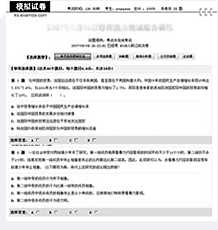试卷简介
试卷预览
Robin: Where are you going,Charlotte?
Charlotte: I am going to the post office.
Robin: What are you going to post?
Charlotte: A letter to my friend.
Robin: (1)
Charlotte: Yes, I know it. But we have kept the habit for many years.
Robin: (2)
Charlotte:That is different.
Robin: But they are more convenient, you need not wait for many days.
Charlotte:That's true. It is just a kind of feeling. (3)
Robin:Oh,it seems more intimate.
Charlotte:That is right. (4)
[A] Why not make a phone call, or write an e-mail?
[B] You can have a try.
[C] Oh,it is rare to write a letter nowadays.
[D] You can see each other's handwriting.
Linda: Lily's birthday is coming. (1)
Lisa: All right. Where and when?
Linda: How about holding it at my home tomorrow night?
Lisa:(2)
Linda:What should we do at the party?
Lisa:Let's have a dinner party. We can put a big table in the TV roomand then we can all eat to-
gether.
Linda: (3)
Lisa: I think it would be fun.
Linda: Yeah. Let's go to the supermarket and buy a lot of things for tomorrow's party.
[A] It's good of you to come.
[B] That sounds like a good idea.
[C] Shall we hold a birthday party for her?
[D] That is just what I wanted to suggest.
Ellen:We're going to have a ten-day vacation. (1)
Peter:I've made up my mind to travel to Guilin with my whole family.
Ellen: Are you driving?
Peter:(2)
Ellen: Will that be very expensive?
Peter: No. I have a friend working in the travel agency. (3)
Ellen:That's great.
Peter: I can't wait to have a look at the beautiful scenery in Guilin.
Ellen: Have a nice trip.
Peter: Thank you.
[A] No, we are going on a package tour.
[B] How did you enjoy your trip?
[C] How will you spend it?
[D] He offers us a huge discount.
Passage One
A few centuries ago, people looked at the birds and wondered what it would be like to fly like them. There were stories of heroes who glued bird feathers on their arms and flew up into the sky. About 500 years ago. Some people dreamed a different dream. Instead of flying up to the sky. They dreamed of falling from the sky!
In the 15th century. Italian inventors designed a cone-shaped (锥形)device that was supposed to bring a man down safely from a great height. The operator held on to a handle with straps strapped to his waist. This was the first known design for a parachute (降落伞)・
Even the great inventor Leonardo da Vinci sketched a type of parachute. His parachute design was in the shape of a pyramid (金字塔).Other inventors also sketched their own designs tor a parachute. Unfortunately, these were only designs on paper and no one tested them.
A Croatian inventor named Fausto Veranzio looked at Leonardo da Vinci's parachute design and replaced the pyramid shape with one that looked like a sail from a ship. When Veranzio was 65 years old, he fell ill. Thinking he would not live longer, he decided to try out his parachute invention. He built his parachute using wood and cloth. Strapping his invention to his waist he jumped off the tall bell tower in his city. He landed safely! He was supposedly the first man to successfully use a parachute. However, some people thought this story was not true. If that was the case, then the first person to successfully use a parachute would go to a Frenchman named Louis-Sebastien Lenormand in 1783.
The first known parachute was designed by ______.
A.Frenchmen
B. Italians
C. Croatians
D. Englishmen
Leonardo da Vinci's parachute was shaped like a ______ .
A. cone
B. feather
C. pyramid
D. sail
Which of the following about Fausto Veranzio is true?
A.He copied da Vinci's parachute design
B.He made his parachute with feather and wood
C.He experimented with his parachute many times
D.He decided to try his parachute after he was seriously ill
As for the first man who successfully used a parachute, _______________.
A.it was said to be Leonardo da Vinci
B.we know for sure he was Veranzio
C.there were some historical records
D.we don’t know for sure yet
The passage is mainly about __________ .
A.the origin of the parachute
B.the dreams of flying and falling
C.the courage of dropping from the sky
D.the application of parachute invention
Passage Two
Out of all the students who enroll in a massive open online course (MOOC), only about 5 pwecent complete the course and receive a certificate of accomplishment. This statistic is often cited as evidence that MOOCs are fatally flawed(缺陷的)and offer little educational value to most students. Yet more than 80 percent oi students who fill out a post-course survey say they met their primary objective. How do we look at these two facts?
We're used to focusing on completion rates in higher education. but they’re not the only—or even the most meaningful—indicator of engagement in open online courses. With no cost to enroll, no punishment for dropping out, and little reward for actually earning a certificate. MOOCs are fundamentally different from traditional classes—and students use them in fundamentally different ways.
Data from more than 1.8 million student enrolled in 36 MOOCs offered by the University of Pennsylvania show that students treat MOOCs like a buffet(自助餐),sampling the material according to their interests and career goals. Some are curious about the subject matter and just watch one or two video lectures; others use the discussion forums to connect with their intellectual peers around the world. Of all enrolled students, nearly 60 percent watch at least one video, complete at least one assignment, or post at least once in a forum.
So focusing on the tiny fraction of students who complete a MOOC is misguided. The more important number is the 60 percent engagement rate. Students may not finish a MOOC with a certificate of accomplishment, but the courses nonetheless meet the educational goals of millions.
What do we learn about MOOCs from Para. 1 ?
A. There seems to be conflicting statistics about MOOCs
B. It turns out that MOOCs have failed people's expectations
C. Most students find it hard to judge the value of MOOCs
D. The educational value of MOOCs is well acknowledged
In Para. 2, the author stresses_________ .
A. the primary objective of MOOC students
B. the significance of completion rates in education
C. the strengths and weaknesses of open online courses
D. the differences between MOOCs and traditional classes
According to Para. 3. Student’s choose MOOCs for the following reasons EXCEP________ .
A. earning a certificate
B. improving job-related skills
C. meeting their interest in the subjects
D. exchanging ideas with students worldwide
The sentence“students treat MOOCs as a buffet” (Para. 3) _______.
A. emphasizes the core value of MOOCs
B. demonstrates the daily operation of MOOCs
C. indicates students are free to choose MOOC resources
D. explains what students learn from MOOC courses
What is the author's attitude toward MOOCs?
A. Critical
B. Supportive
C. Indifferent
D. Neutral

 最新推荐
最新推荐
 相关试卷
相关试卷

 原创试题专区
原创试题专区 开通学校服务
开通学校服务







